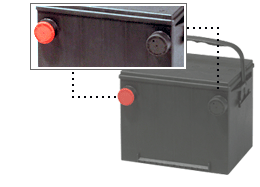Terminal Types
 Top Terminal Batteries Top Terminal Batteries
These batteries have terminal posts on top to enable a cable connection to the top of the battery. This top post design is built to Society of Automotive Engineers' Standards (SAE) so that all cable clamps will fit any battery with these posts. The positive terminal is slightly larger than the negative to minimize the danger of installing a battery in reverse.
This design is used in almost all non-GM vehicles.
 Side Terminal Batteries Side Terminal Batteries
These batteries have terminals molded into the side wall of the container near the top edge. Each battery cable is attached to the terminal by a bolt, which threads into the terminal. With the terminal on the battery's side, instead of the top, the overall height of the battery is reduced. To obtain a good electrical contact without damaging the terminal socket, never use bolts in the side terminals longer than the original side terminal bolts.
Too long of a bolt will pierce the side terminal and cause a leak. Do not over-tighten bolts. Use a torque wrench setting between 6 to 8 foot-pounds.
It is important to replace the lead bushing that is place in the terminal when there is a dual cable application. Failure to replace this bushing can result in side terminal leaks because the OE bolt now penetrates the side terminal too deep.
A side terminal design is almost exclusively used in GM vehicles.
 Dual Terminal Batteries Dual Terminal Batteries
Batteries with both top and side terminals are called Dual Terminal batteries. This universal design provides greater flexibility for installation by fitting applications requiring either top or side terminal batteries. This design helps reduce the number of SKU's required to fit replacement battery needs.
|
Starting, Lighting, and Ignition (S.L.I.)
The three basic functions a battery has to perform to service most vehicles is Starting, Lighting and Ignition, or 'S.L.I'. Batteries that fall under the S.L.I. description are designed for voltage controlled electrical systems found in passenger cars, light trucks and vans. Commercial batteries, as well as other special applications including marine, RV, lawn & garden, power sports, etc also fall under this category. There are 7 main categories of S.L.I. batteries, as follows.
Maintenance-Free Batteries
Maintenance-free batteries are designed to reduce water loss for longer service life. Carquest Batteries are truly maintenance free in that both the positive and negative plates/grids are made of calcium lead-alloys. This calcium/calcium construction reduces gassing and water loss, and, provides superior cranking performance. Other advantages of calcium/calcium construction include prolonged shelf life, greater overcharge resistance and reduced terminal corrosion and the elimination of overfilling or adding harmful impurities. Most Original Equipment batteries for cars and light trucks today, utilize calcium/calcium construction.
Maintenance Accessible Batteries
Removable vent caps allow periodic addition of water to the electrolyte. Maintenance accessible batteries may be found in applications such as marine, heavy duty/commercial and farm.
Low-Antimony Batteries
Both positive and negative plates/grids are built with approximately 2.5% antimony content. These batteries gas, resulting in water loss and have a short shelf life - requiring repeated recharges. However, low-antimony batteries are frequently used in deep cycle applications such as marine, wheelchair, scrubber/sweepers, that require frequent discharge and recharge cycles. Low antimony batteries are maintenance accessible.
Wet/Flooded Batteries
Batteries that are filled at the factory and shipped "ready to install." Wet/Flooded batteries are the most widely used in automotive applications. They are usually less expensive than Gel or AGM batteries, but do not provide the same cycle life and convenience. Some wet/flooded batteries require maintenance (See Maintenance Accessible Batteries).
SVR Gel
Sealed, Valve-Regulated (SVR) Gelled electrolyte batteries offer many significant advantages over conventional "flooded" batteries. Gel batteries are spillproof and leakproof, and resist over-discharges that can shorten the life of the battery. The 'ultimate deep cycle battery', gel batteries can be discharged and recharged more often than any other battery type. For maximum life and performance, a gel friendly charger must be used.
Gel batteries have a very low self-discharge rate so they can go longer without recharging. While providing superior auxiliary power, they can also be used for cranking. Their SVR design minimizes gassing, making them safe to install around people and sensitive electronic equipment. Gel batteries are maintenance-free and must never be opened.
SVR Absorbed Glass Mat (AGM)
Sealed, Valve-Regulated (SVR) Absorbed Glass Mat (AGM) batteries use special absorbed electrolyte technology. Fine, highly porous micro-fiber glass separators absorb the electrolyte, increasing efficiency by lowering internal resistance and boosting capacity. Lower internal resistance also means that the batteries can be recharged faster than conventional batteries, allowing the user to put them back into operation sooner. In contrast to SVR Gel batteries, the SVR AGM excels in high current, high power applications, as well as auxiliary power for dual-purpose applications.
The completely sealed, valve-regulated AGM battery is vibration resistant, and eliminates gas emissions and acid leakage for longer and safer battery operation. AGM batteries are also completely maintenance-free and must never be opened.
Dry-Charged Batteries
Dry-charged batteries must be filled with electrolyte or "activated" and then boosted before being placed in service. The battery's plates are pre-charged so they become activated after the electrolyte is added. The advantage of dry-charged batteries is long, indefinite shelf life before electrolyte is added. |
